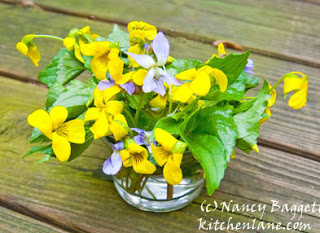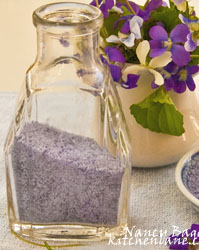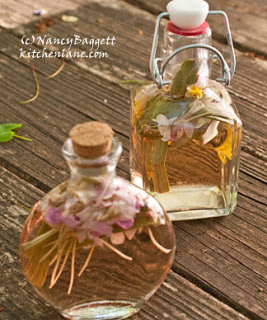Time is running out! Well it is if you love woodland violets and live here in central Maryland. The vast purple-blue carpet where I harvested a whole basket of beauties ten days ago has now vanished from my neighbor’s untended side yard. Now, blooms are only popping up in the cooler, shadier parts of my garden and in the woods. In another week all the violets will be gone until next year.


So, with a sense of urgency, this past month I have been busily enjoying these small, but abundant gifts of nature in as many ways as possible. Yes, they make gorgeous miniature floral arrangements for coffee and tea trays and small tables and nooks. (Almost any mother’s heart would melt at being presented with this sweet little violet bouquet brightening her Sunday breakfast-in-bed tray, don’t you think?)
But because wild violets (like other members of the large Viola family) are edible, they offer many more opportunities to take advantage of their cheerful hues and form. I strew them on salads and toss them into vinaigrettes. I perch them, sometimes fresh, sometimes candied, atop cookies, cupcakes, and such; they add not only charm, but a touch of color that, happily, is completely dye-free. An additional pastry decorating trick: I turn the petals (almost effortlessly) into a pretty garnishing sugar that can be kept on hand to gussy up all manner of sweet treats. (Note that, despite their name, African violets are not in the Viola family and cannot be eaten.) 
This week I’ve been experimenting with another fun, easy way to spotlight fresh woodland violets–combining them with chives or parsley to create beautiful bottles of seasoned herbed vinegar. These make wonderful kitchen gifts for all sorts of cooks, from salad lovers, herb fans, and healthy eaters to waist watchers, vegans, and the gluten-free.
To streamline the steps and make preparations utterly fuss-free, this recipe calls for seasoned rice vinegar (though you could certainly use unseasoned, if preferred). I like the Nakano brand version labled “all natural, original.” The seasoned kinds already contain a modicum of salt and sugar, so as soon as the bottle has steeped a few days, the vinegar can be whisked together with oil for an instant vinaigrette. Or, splash the vinegar, as is, over bitter greens, or cooked veggies, or into a quick pan sauce.
IMO rice vinegar is the best choice because it’s fairly economical and has a mild flavor and pale hue that really showcases the taste of the herbs and color of the violets. It’s normal for the color from purple violets to gradually leach from the blooms and tint the vinegar a pinkish shade (as shown in the bottom pic). Real woodland violets of any color work well. Just be sure they are untreated and unsprayed. Either garlic chives or regular chives (including any blooms) will do. The parsley is optional; if you use it choose the flat-leaf kind.
Directions for 1 bottle of violet vinegar:
 Wash a handful of violets (with or without stems) and some chives in a colander (and also parsley if using) thoroughly but gently under barely warm water. Then drain well and gently dry on paper towels.
Wash a handful of violets (with or without stems) and some chives in a colander (and also parsley if using) thoroughly but gently under barely warm water. Then drain well and gently dry on paper towels.
Fill whatever size clear glass bottle or jar you like three-fourths full with the rice vinegar. If the bottle opening or neck is narrow, be sure to have on hand a thin, long-handled fork (such as a fondue fork), chopstick, or extra-long, thin tweezers to push the blooms and herbs down into the container. If necessary cut the chives the length needed so they will “stand up” in the bottle.
Gently push some herb sprigs and as many violets as look attractive down into the bottle; be sure that all are covered with the vinegar. Add more vinegar to top off the bottle and cover the herbs as they float to the top. Close tightly with a non-reactive cap or a cork. Let stand in a cool, dark spot several days so the flavors can blend before using. The violet colors begin to fade right away; the herb flavors fade within about 8 months, though the vinegar can be used for up to a year.



Spring in a bottle–yes that sums it up nicely. And a good way to save some for after it's gone.
Wow! Spring in a bottle!
Great pictures. When I was very little, my mom would take me out to pick violets, and we'd come back with a huge bunch. I wonder what the people thought who came out and found all their violet blooms gone.
Lovely photography! I miss my violets – they don't grow here in TX. You've come up with a wonderful and tasty way to preserve and enjoy them. And I could almost eat the pictures!